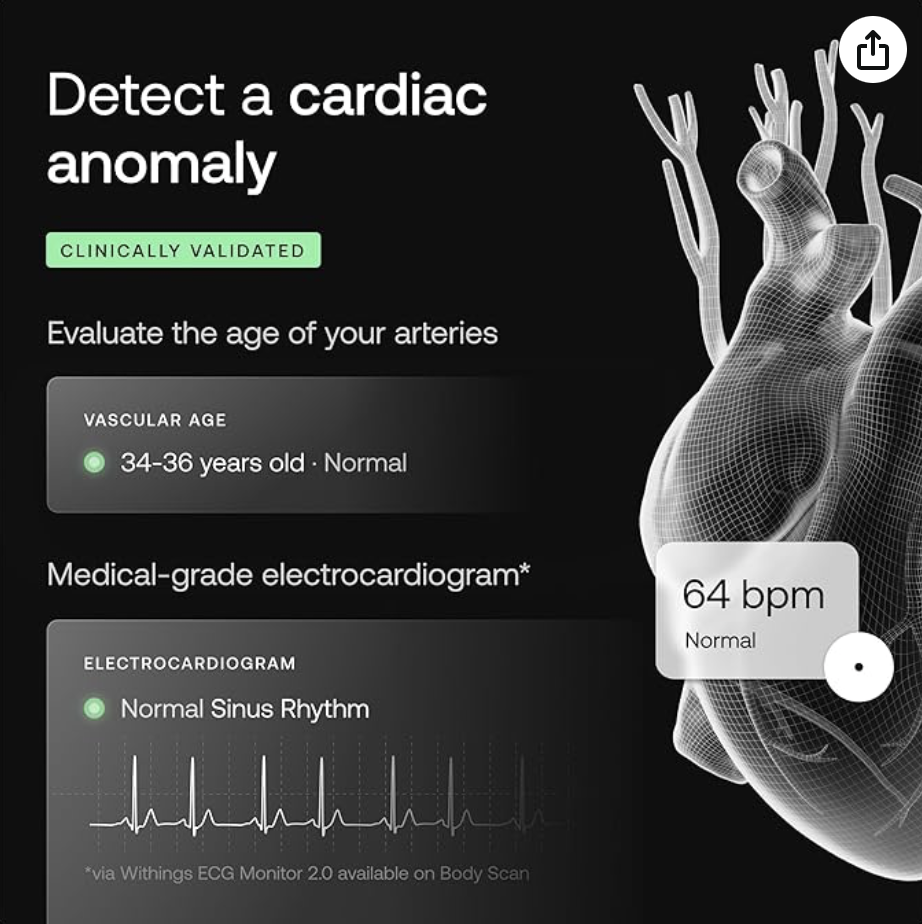Have you ever wondered how “old” your body really is—not in birthdays, but in vitality?
You might be surprised to learn that your arteries can tell a very different story than your driver’s license. This concept is known as vascular age, and it’s quickly becoming one of the most accurate ways to measure your true biological age—especially when it comes to heart health, longevity, and graceful aging.
So let’s dive into this fascinating topic, explore what pulse wave velocity is, reveal an easy way to check cardiovascular health at home—no doctor visit required, look at the natural ways to improve your arterial health, and hopefully help you optimise your vascular age.
What Is Vascular Age (And How Is It Different From Biological Age)?
Your biological age is an estimate of how old your body appears to be based on function and cellular health, not calendar years. Vascular age focuses specifically on the age of your arterial system—the health, flexibility, and function of your arteries.
In other words, you could be 60 but have the arteries of someone in their 40s… or vice versa.
The key to understanding vascular age lies in a concept called pulse wave velocity.
Pulse Wave Velocity Explained
Pulse wave velocity (PWV) is the speed at which the pressure wave from each heartbeat travels through your arteries. Think of your arteries like garden hoses: when they’re young and supple, the pulse moves slowly and steadily. As they stiffen with age or inflammation, the pulse moves faster.
So, the faster your pulse moves, the greater your PWV measurement will be, the older your arteries likely are.
Why Pulse Wave Velocity Matters
PWV is considered one of the most accurate predictors of cardiovascular health and overall longevity. According to recent studies, it may even outperform blood pressure or cholesterol levels in forecasting heart disease and stroke risk.
That’s huge. Especially for anyone over 40 who want to take proactive steps in their health journey.
And the best part? You can now measure pulse wave velocity at home.
How to Measure Cardiovascular Pulse Wave Velocity at Home
Until recently, testing PWV required a trip to a clinic or lab. But now, with the rise of smart health tech, it’s easier than ever to measure cardiovascular health at home using devices like the Withings Body Scan Scale which is available at Amazon.
This smart scale uses a process called ballistocardiography to detect the force of blood leaving your heart and the time it takes to reach your feet. It then calculates your vascular age and PWV right from your bathroom floor.
📱 Syncing with the Withings App
These scales integrate seamlessly with the Withings Health Mate app, allowing you to view your PWV and vascular age metrics alongside other health data. Ensure you complete the initial setup and perform multiple weigh-ins to activate all features.
Pro Tip: Although some features (like visible PWV data) may be limited in certain regions, there are workarounds—such as exporting the data manually or using third-party apps like LiLo that connect with your Withings account.
Natural Ways to Improve Pulse Wave Velocity
Now for the empowering part: yes, you can improve your vascular age. Here are some natural ways to improve pulse wave velocity and keep your arteries young and resilient:
1. Move Your Body Daily
- Aerobic exercise (like brisk walking, cycling, or swimming) improves arterial elasticity.
- Aim for at least 30 minutes of moderate activity most days.
2. Eat Artery-Friendly Foods
- Foods rich in nitrates (beets, leafy greens), antioxidants, and omega-3 fatty acids support the endothelium—the inner lining of your arteries.
- Reduce sugar and processed foods that trigger inflammation.
3. Reduce Stress
- Chronic stress stiffens arteries. Practice Tai Chi, breathwork, or meditation regularly to lower cortisol and improve heart variability.
4. Prioritize Sleep
- Quality sleep helps regulate blood pressure and arterial recovery.
- Aim for 7–8 hours of restful sleep nightly.
5. Hydrate Well
- Dehydration thickens your blood and puts strain on your vascular system.
- Keep water intake consistent, especially in warmer months or after exercise.
6. Track Your Progress
- Whether using a scale like Withings or a fitness smartwatch, track your PWV trends over time to stay motivated and proactive.
How to Best Measure Cardiovascular Health at Home
If you want a quick recap, here’s what I recommend:
- Step on a Withings Body Scan Scale regularly (ideally daily or weekly).
- Export your PWV and vascular age data for deeper insights.
- Compare your progress over time—look for trends, not one-off results.
- Incorporate lifestyle changes that directly improve vascular elasticity.
Your arteries will thank you—and so will your future self.
Final Thoughts
Aging gracefully isn’t about chasing youth—it’s about protecting function, vitality, and independence. Knowing your vascular age and learning how to improve your pulse wave velocity gives you a powerful, science-backed tool to stay ahead of the curve.
With just a few lifestyle tweaks and the right technology, you can start measuring cardiovascular pulse wave velocity at home and take control of your long-term heart health—naturally.
For more comprehensive information about this topic you may like to read Dr. Lutz Kraushaar article on Medium.com – Is Enviable Longevity Your True North? Vascular Age Should Be Your Navi. You might also like to subscribe to Substack Newsletter Double Check Doc.
Affiliate Partner Disclosure – This article may contain affiliate links allowing me to earn a small commission (at no extra cost to you) when you purchase through these links. Thank you for supporting my website.
